Australian Red Cross Services for Aged and Homeless: Sociology Report
VerifiedAdded on 2023/01/16
|9
|2197
|36
Report
AI Summary
This sociology report delves into the Australian Red Cross's provision of welfare services, focusing on their support for the aged population and individuals experiencing homelessness. The report begins by outlining the Red Cross's mission and vision, emphasizing their commitment to humanitarian activities and the prevention of human suffering. It then examines the demographic context of Australia's aging population and the Red Cross's response through in-home aged care, including home care packages and support programs. The report also explores the Red Cross's efforts to address food insecurity and provide healthcare services to the elderly. Furthermore, the report analyzes the Red Cross's initiatives to assist homeless individuals, including maintaining housing, building life skills, and fostering community connections. The analysis draws on various academic sources and concludes by highlighting the Red Cross's significant contributions to welfare in Australia, emphasizing their role in supporting vulnerable populations and promoting human dignity. The report also includes a reflection on the author's perspective and the impact of Red Cross services.
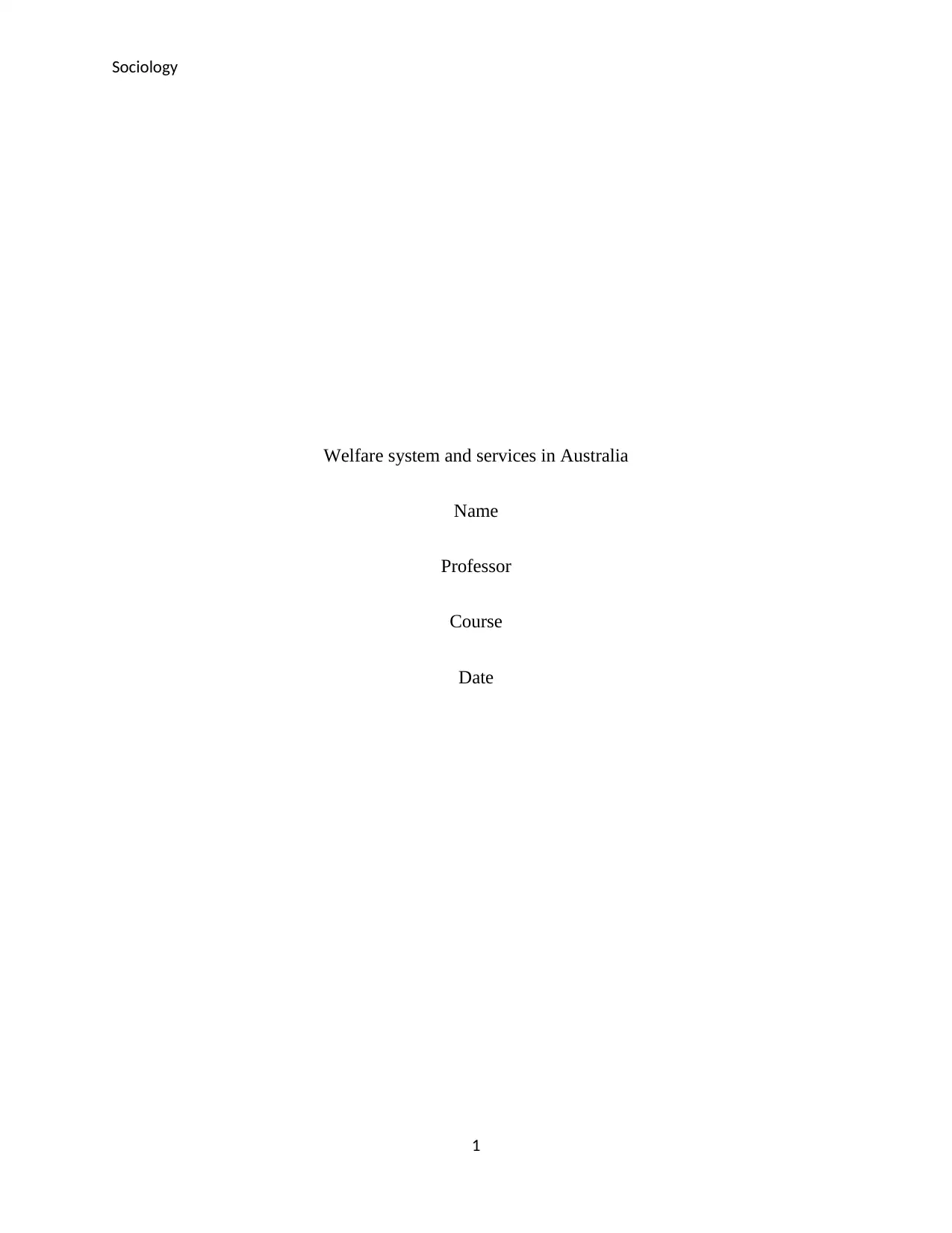
Sociology
Welfare system and services in Australia
Name
Professor
Course
Date
1
Welfare system and services in Australia
Name
Professor
Course
Date
1
Paraphrase This Document
Need a fresh take? Get an instant paraphrase of this document with our AI Paraphraser
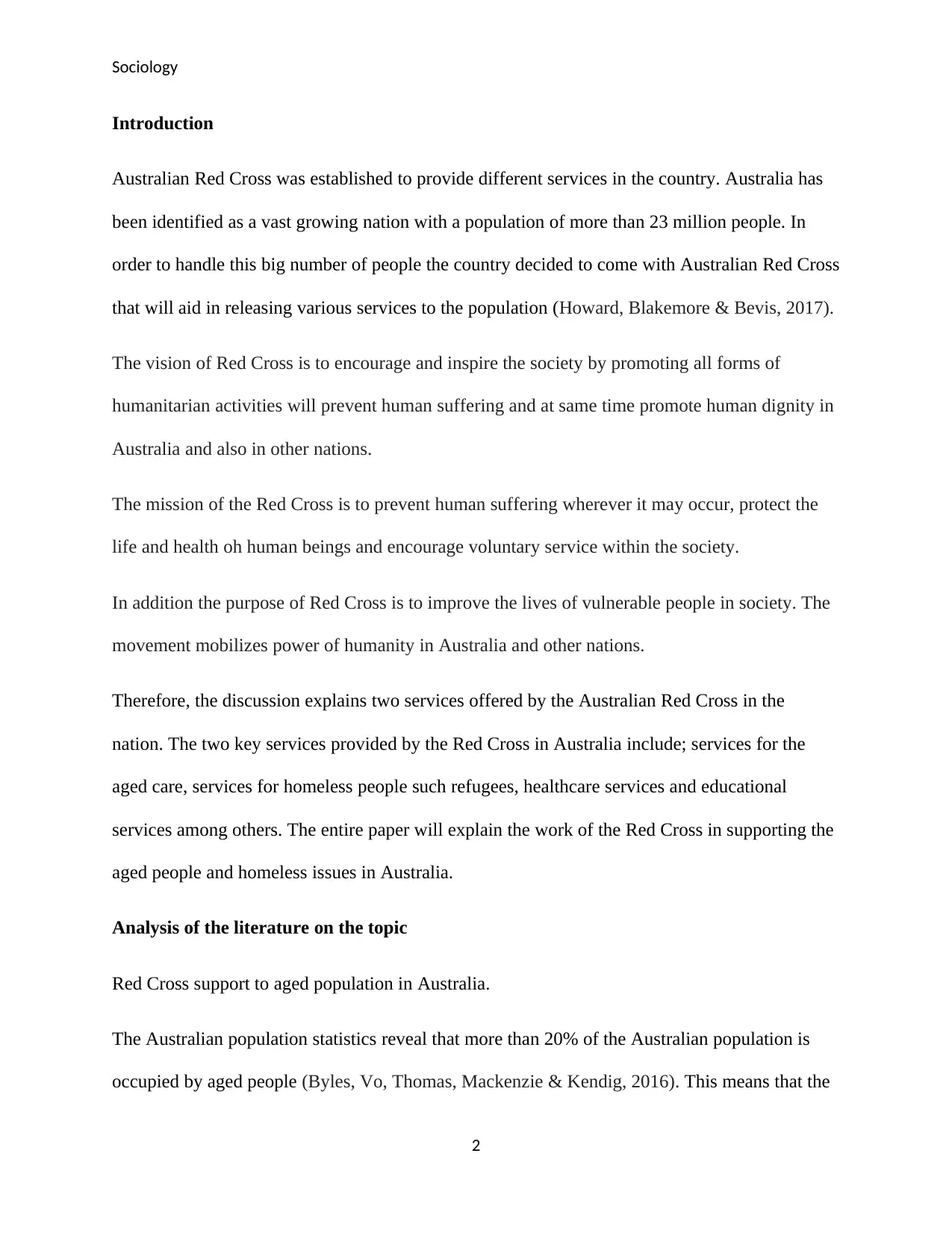
Sociology
Introduction
Australian Red Cross was established to provide different services in the country. Australia has
been identified as a vast growing nation with a population of more than 23 million people. In
order to handle this big number of people the country decided to come with Australian Red Cross
that will aid in releasing various services to the population (Howard, Blakemore & Bevis, 2017).
The vision of Red Cross is to encourage and inspire the society by promoting all forms of
humanitarian activities will prevent human suffering and at same time promote human dignity in
Australia and also in other nations.
The mission of the Red Cross is to prevent human suffering wherever it may occur, protect the
life and health oh human beings and encourage voluntary service within the society.
In addition the purpose of Red Cross is to improve the lives of vulnerable people in society. The
movement mobilizes power of humanity in Australia and other nations.
Therefore, the discussion explains two services offered by the Australian Red Cross in the
nation. The two key services provided by the Red Cross in Australia include; services for the
aged care, services for homeless people such refugees, healthcare services and educational
services among others. The entire paper will explain the work of the Red Cross in supporting the
aged people and homeless issues in Australia.
Analysis of the literature on the topic
Red Cross support to aged population in Australia.
The Australian population statistics reveal that more than 20% of the Australian population is
occupied by aged people (Byles, Vo, Thomas, Mackenzie & Kendig, 2016). This means that the
2
Introduction
Australian Red Cross was established to provide different services in the country. Australia has
been identified as a vast growing nation with a population of more than 23 million people. In
order to handle this big number of people the country decided to come with Australian Red Cross
that will aid in releasing various services to the population (Howard, Blakemore & Bevis, 2017).
The vision of Red Cross is to encourage and inspire the society by promoting all forms of
humanitarian activities will prevent human suffering and at same time promote human dignity in
Australia and also in other nations.
The mission of the Red Cross is to prevent human suffering wherever it may occur, protect the
life and health oh human beings and encourage voluntary service within the society.
In addition the purpose of Red Cross is to improve the lives of vulnerable people in society. The
movement mobilizes power of humanity in Australia and other nations.
Therefore, the discussion explains two services offered by the Australian Red Cross in the
nation. The two key services provided by the Red Cross in Australia include; services for the
aged care, services for homeless people such refugees, healthcare services and educational
services among others. The entire paper will explain the work of the Red Cross in supporting the
aged people and homeless issues in Australia.
Analysis of the literature on the topic
Red Cross support to aged population in Australia.
The Australian population statistics reveal that more than 20% of the Australian population is
occupied by aged people (Byles, Vo, Thomas, Mackenzie & Kendig, 2016). This means that the
2
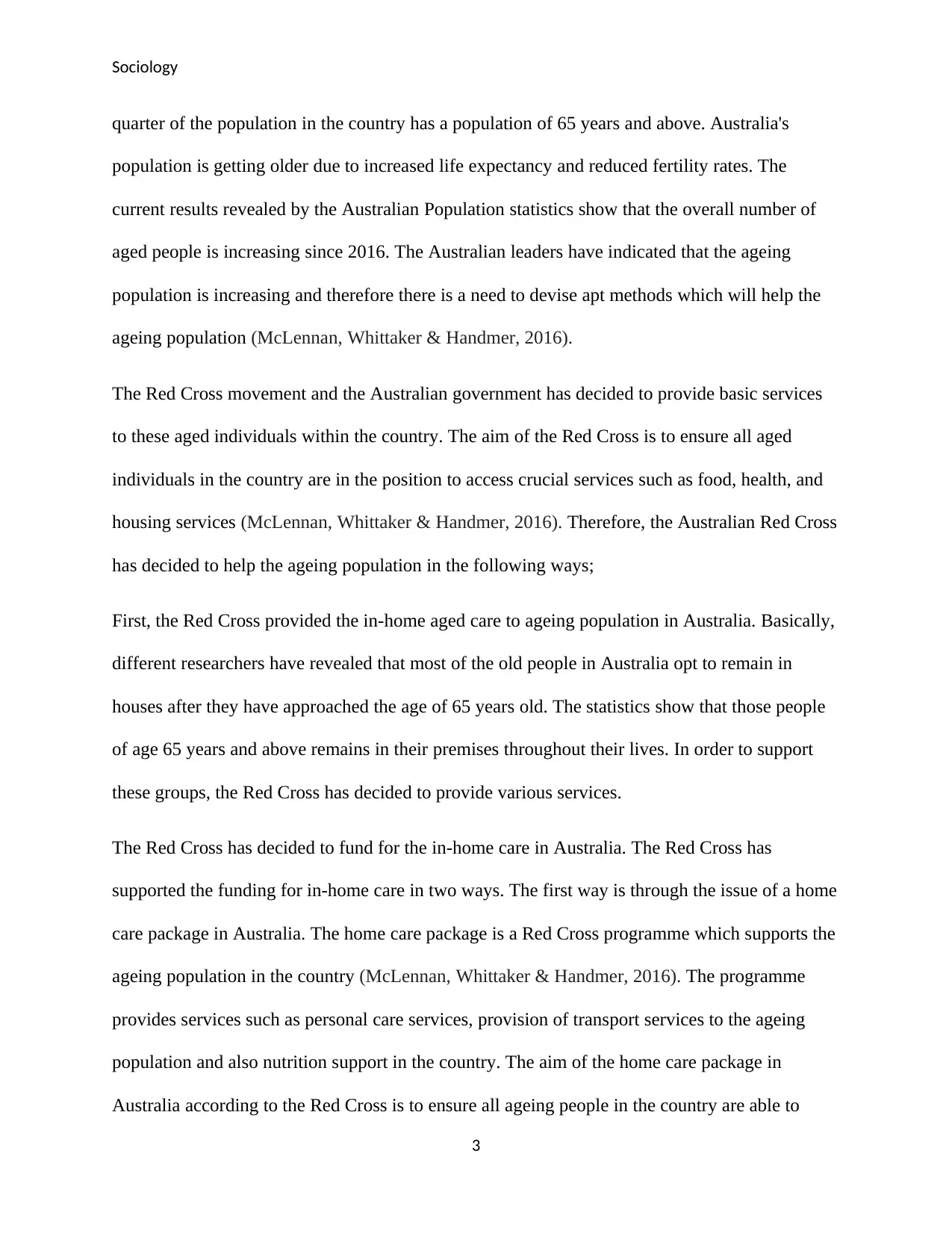
Sociology
quarter of the population in the country has a population of 65 years and above. Australia's
population is getting older due to increased life expectancy and reduced fertility rates. The
current results revealed by the Australian Population statistics show that the overall number of
aged people is increasing since 2016. The Australian leaders have indicated that the ageing
population is increasing and therefore there is a need to devise apt methods which will help the
ageing population (McLennan, Whittaker & Handmer, 2016).
The Red Cross movement and the Australian government has decided to provide basic services
to these aged individuals within the country. The aim of the Red Cross is to ensure all aged
individuals in the country are in the position to access crucial services such as food, health, and
housing services (McLennan, Whittaker & Handmer, 2016). Therefore, the Australian Red Cross
has decided to help the ageing population in the following ways;
First, the Red Cross provided the in-home aged care to ageing population in Australia. Basically,
different researchers have revealed that most of the old people in Australia opt to remain in
houses after they have approached the age of 65 years old. The statistics show that those people
of age 65 years and above remains in their premises throughout their lives. In order to support
these groups, the Red Cross has decided to provide various services.
The Red Cross has decided to fund for the in-home care in Australia. The Red Cross has
supported the funding for in-home care in two ways. The first way is through the issue of a home
care package in Australia. The home care package is a Red Cross programme which supports the
ageing population in the country (McLennan, Whittaker & Handmer, 2016). The programme
provides services such as personal care services, provision of transport services to the ageing
population and also nutrition support in the country. The aim of the home care package in
Australia according to the Red Cross is to ensure all ageing people in the country are able to
3
quarter of the population in the country has a population of 65 years and above. Australia's
population is getting older due to increased life expectancy and reduced fertility rates. The
current results revealed by the Australian Population statistics show that the overall number of
aged people is increasing since 2016. The Australian leaders have indicated that the ageing
population is increasing and therefore there is a need to devise apt methods which will help the
ageing population (McLennan, Whittaker & Handmer, 2016).
The Red Cross movement and the Australian government has decided to provide basic services
to these aged individuals within the country. The aim of the Red Cross is to ensure all aged
individuals in the country are in the position to access crucial services such as food, health, and
housing services (McLennan, Whittaker & Handmer, 2016). Therefore, the Australian Red Cross
has decided to help the ageing population in the following ways;
First, the Red Cross provided the in-home aged care to ageing population in Australia. Basically,
different researchers have revealed that most of the old people in Australia opt to remain in
houses after they have approached the age of 65 years old. The statistics show that those people
of age 65 years and above remains in their premises throughout their lives. In order to support
these groups, the Red Cross has decided to provide various services.
The Red Cross has decided to fund for the in-home care in Australia. The Red Cross has
supported the funding for in-home care in two ways. The first way is through the issue of a home
care package in Australia. The home care package is a Red Cross programme which supports the
ageing population in the country (McLennan, Whittaker & Handmer, 2016). The programme
provides services such as personal care services, provision of transport services to the ageing
population and also nutrition support in the country. The aim of the home care package in
Australia according to the Red Cross is to ensure all ageing people in the country are able to
3
⊘ This is a preview!⊘
Do you want full access?
Subscribe today to unlock all pages.

Trusted by 1+ million students worldwide
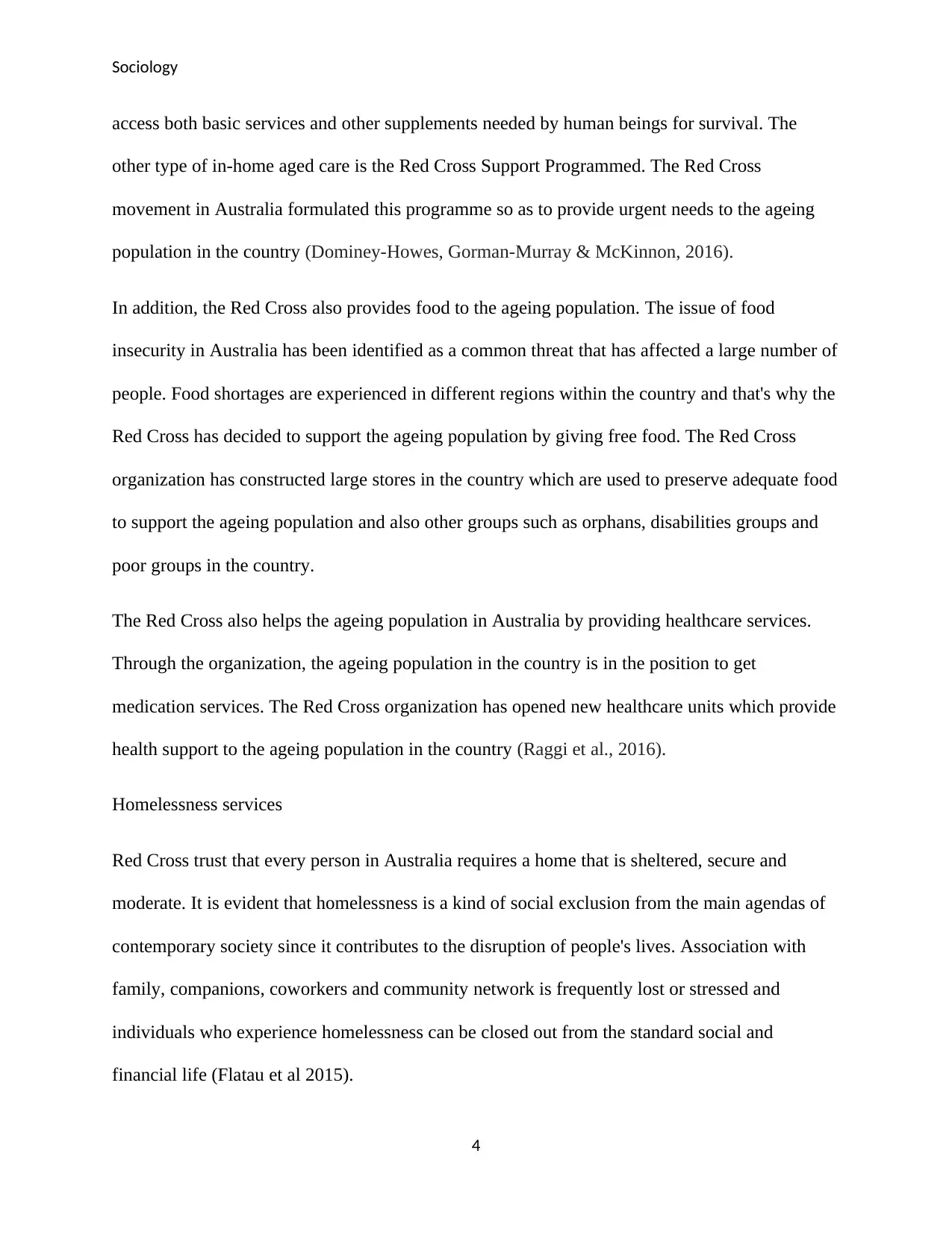
Sociology
access both basic services and other supplements needed by human beings for survival. The
other type of in-home aged care is the Red Cross Support Programmed. The Red Cross
movement in Australia formulated this programme so as to provide urgent needs to the ageing
population in the country (Dominey-Howes, Gorman-Murray & McKinnon, 2016).
In addition, the Red Cross also provides food to the ageing population. The issue of food
insecurity in Australia has been identified as a common threat that has affected a large number of
people. Food shortages are experienced in different regions within the country and that's why the
Red Cross has decided to support the ageing population by giving free food. The Red Cross
organization has constructed large stores in the country which are used to preserve adequate food
to support the ageing population and also other groups such as orphans, disabilities groups and
poor groups in the country.
The Red Cross also helps the ageing population in Australia by providing healthcare services.
Through the organization, the ageing population in the country is in the position to get
medication services. The Red Cross organization has opened new healthcare units which provide
health support to the ageing population in the country (Raggi et al., 2016).
Homelessness services
Red Cross trust that every person in Australia requires a home that is sheltered, secure and
moderate. It is evident that homelessness is a kind of social exclusion from the main agendas of
contemporary society since it contributes to the disruption of people's lives. Association with
family, companions, coworkers and community network is frequently lost or stressed and
individuals who experience homelessness can be closed out from the standard social and
financial life (Flatau et al 2015).
4
access both basic services and other supplements needed by human beings for survival. The
other type of in-home aged care is the Red Cross Support Programmed. The Red Cross
movement in Australia formulated this programme so as to provide urgent needs to the ageing
population in the country (Dominey-Howes, Gorman-Murray & McKinnon, 2016).
In addition, the Red Cross also provides food to the ageing population. The issue of food
insecurity in Australia has been identified as a common threat that has affected a large number of
people. Food shortages are experienced in different regions within the country and that's why the
Red Cross has decided to support the ageing population by giving free food. The Red Cross
organization has constructed large stores in the country which are used to preserve adequate food
to support the ageing population and also other groups such as orphans, disabilities groups and
poor groups in the country.
The Red Cross also helps the ageing population in Australia by providing healthcare services.
Through the organization, the ageing population in the country is in the position to get
medication services. The Red Cross organization has opened new healthcare units which provide
health support to the ageing population in the country (Raggi et al., 2016).
Homelessness services
Red Cross trust that every person in Australia requires a home that is sheltered, secure and
moderate. It is evident that homelessness is a kind of social exclusion from the main agendas of
contemporary society since it contributes to the disruption of people's lives. Association with
family, companions, coworkers and community network is frequently lost or stressed and
individuals who experience homelessness can be closed out from the standard social and
financial life (Flatau et al 2015).
4
Paraphrase This Document
Need a fresh take? Get an instant paraphrase of this document with our AI Paraphraser
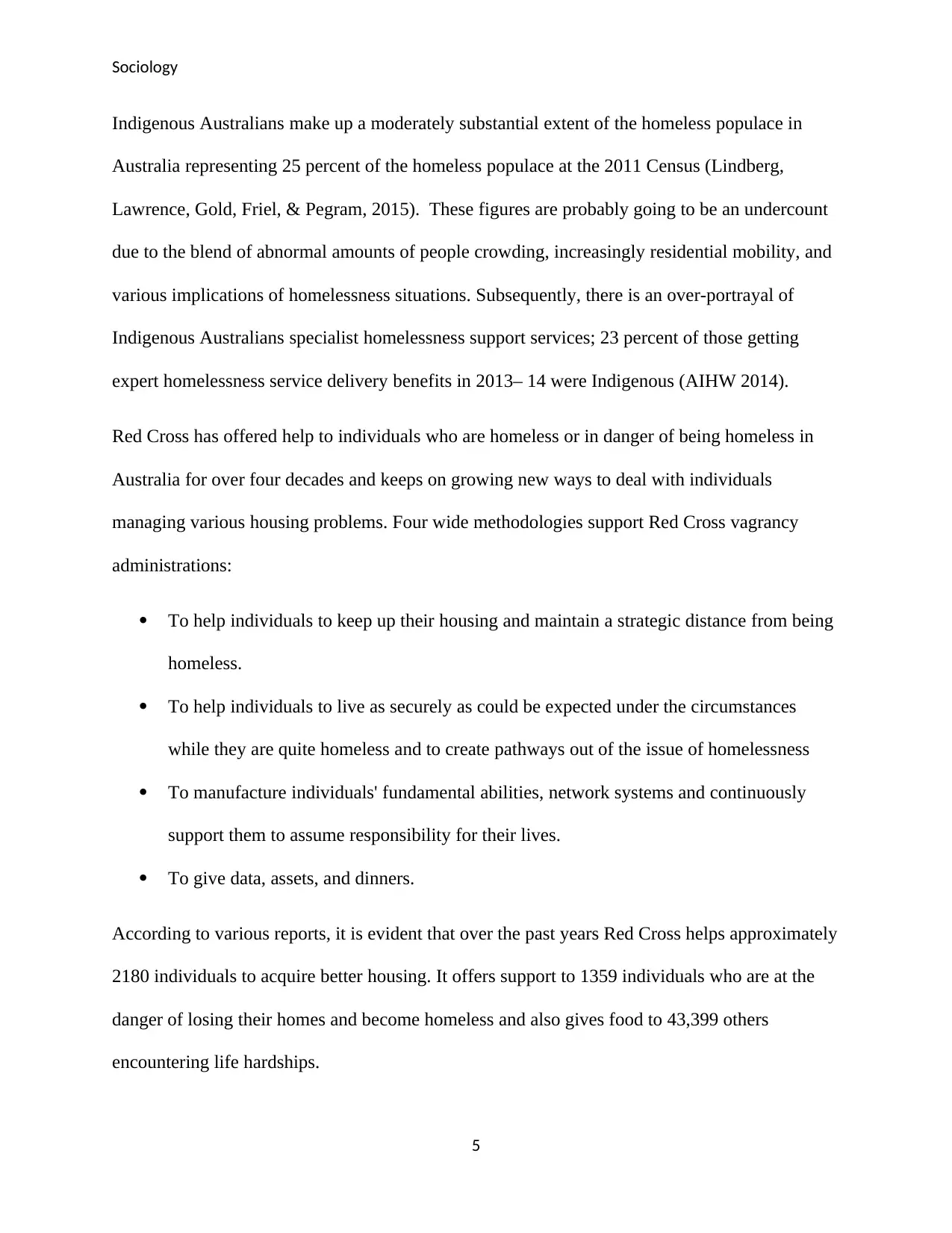
Sociology
Indigenous Australians make up a moderately substantial extent of the homeless populace in
Australia representing 25 percent of the homeless populace at the 2011 Census (Lindberg,
Lawrence, Gold, Friel, & Pegram, 2015). These figures are probably going to be an undercount
due to the blend of abnormal amounts of people crowding, increasingly residential mobility, and
various implications of homelessness situations. Subsequently, there is an over-portrayal of
Indigenous Australians specialist homelessness support services; 23 percent of those getting
expert homelessness service delivery benefits in 2013– 14 were Indigenous (AIHW 2014).
Red Cross has offered help to individuals who are homeless or in danger of being homeless in
Australia for over four decades and keeps on growing new ways to deal with individuals
managing various housing problems. Four wide methodologies support Red Cross vagrancy
administrations:
To help individuals to keep up their housing and maintain a strategic distance from being
homeless.
To help individuals to live as securely as could be expected under the circumstances
while they are quite homeless and to create pathways out of the issue of homelessness
To manufacture individuals' fundamental abilities, network systems and continuously
support them to assume responsibility for their lives.
To give data, assets, and dinners.
According to various reports, it is evident that over the past years Red Cross helps approximately
2180 individuals to acquire better housing. It offers support to 1359 individuals who are at the
danger of losing their homes and become homeless and also gives food to 43,399 others
encountering life hardships.
5
Indigenous Australians make up a moderately substantial extent of the homeless populace in
Australia representing 25 percent of the homeless populace at the 2011 Census (Lindberg,
Lawrence, Gold, Friel, & Pegram, 2015). These figures are probably going to be an undercount
due to the blend of abnormal amounts of people crowding, increasingly residential mobility, and
various implications of homelessness situations. Subsequently, there is an over-portrayal of
Indigenous Australians specialist homelessness support services; 23 percent of those getting
expert homelessness service delivery benefits in 2013– 14 were Indigenous (AIHW 2014).
Red Cross has offered help to individuals who are homeless or in danger of being homeless in
Australia for over four decades and keeps on growing new ways to deal with individuals
managing various housing problems. Four wide methodologies support Red Cross vagrancy
administrations:
To help individuals to keep up their housing and maintain a strategic distance from being
homeless.
To help individuals to live as securely as could be expected under the circumstances
while they are quite homeless and to create pathways out of the issue of homelessness
To manufacture individuals' fundamental abilities, network systems and continuously
support them to assume responsibility for their lives.
To give data, assets, and dinners.
According to various reports, it is evident that over the past years Red Cross helps approximately
2180 individuals to acquire better housing. It offers support to 1359 individuals who are at the
danger of losing their homes and become homeless and also gives food to 43,399 others
encountering life hardships.
5
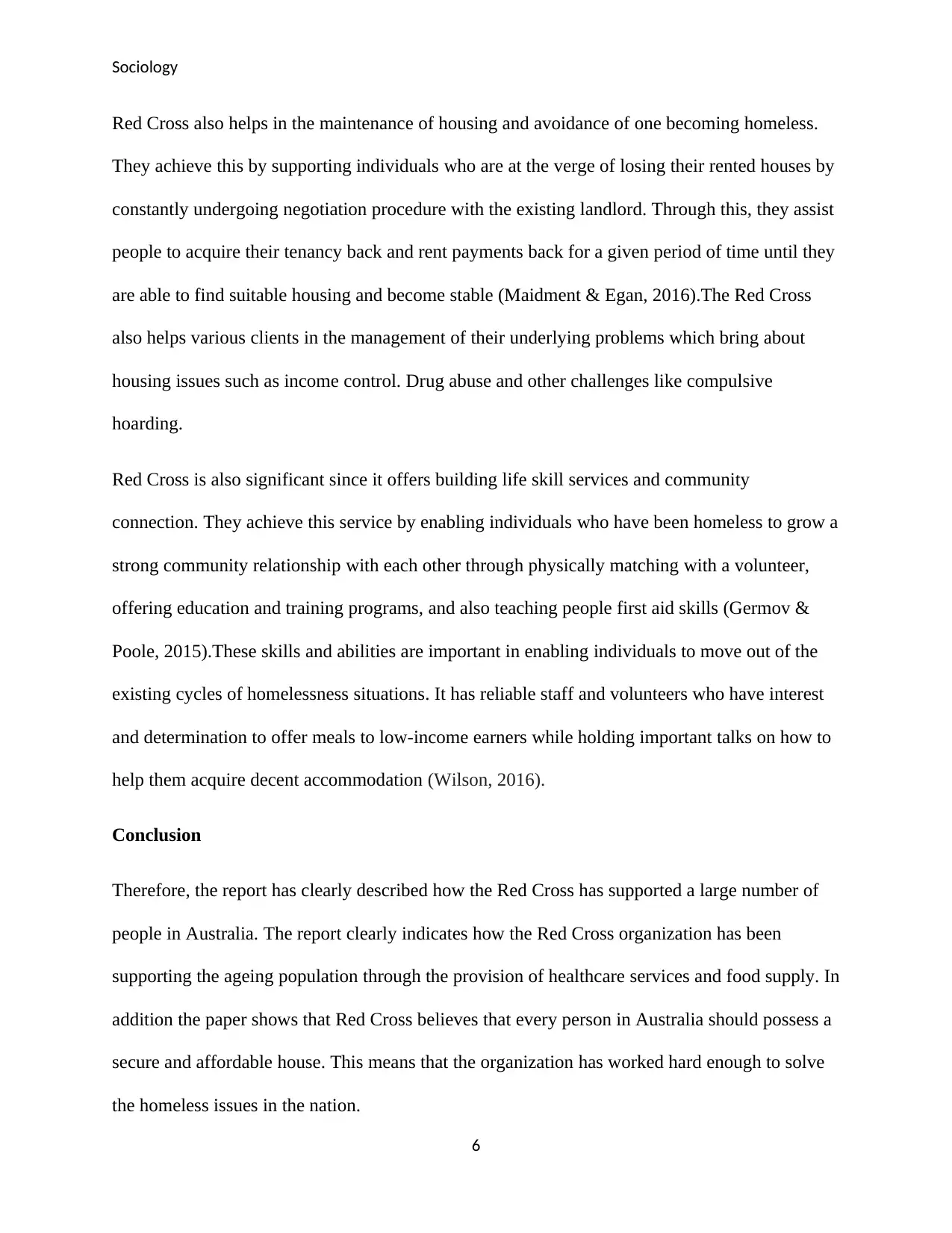
Sociology
Red Cross also helps in the maintenance of housing and avoidance of one becoming homeless.
They achieve this by supporting individuals who are at the verge of losing their rented houses by
constantly undergoing negotiation procedure with the existing landlord. Through this, they assist
people to acquire their tenancy back and rent payments back for a given period of time until they
are able to find suitable housing and become stable (Maidment & Egan, 2016).The Red Cross
also helps various clients in the management of their underlying problems which bring about
housing issues such as income control. Drug abuse and other challenges like compulsive
hoarding.
Red Cross is also significant since it offers building life skill services and community
connection. They achieve this service by enabling individuals who have been homeless to grow a
strong community relationship with each other through physically matching with a volunteer,
offering education and training programs, and also teaching people first aid skills (Germov &
Poole, 2015).These skills and abilities are important in enabling individuals to move out of the
existing cycles of homelessness situations. It has reliable staff and volunteers who have interest
and determination to offer meals to low-income earners while holding important talks on how to
help them acquire decent accommodation (Wilson, 2016).
Conclusion
Therefore, the report has clearly described how the Red Cross has supported a large number of
people in Australia. The report clearly indicates how the Red Cross organization has been
supporting the ageing population through the provision of healthcare services and food supply. In
addition the paper shows that Red Cross believes that every person in Australia should possess a
secure and affordable house. This means that the organization has worked hard enough to solve
the homeless issues in the nation.
6
Red Cross also helps in the maintenance of housing and avoidance of one becoming homeless.
They achieve this by supporting individuals who are at the verge of losing their rented houses by
constantly undergoing negotiation procedure with the existing landlord. Through this, they assist
people to acquire their tenancy back and rent payments back for a given period of time until they
are able to find suitable housing and become stable (Maidment & Egan, 2016).The Red Cross
also helps various clients in the management of their underlying problems which bring about
housing issues such as income control. Drug abuse and other challenges like compulsive
hoarding.
Red Cross is also significant since it offers building life skill services and community
connection. They achieve this service by enabling individuals who have been homeless to grow a
strong community relationship with each other through physically matching with a volunteer,
offering education and training programs, and also teaching people first aid skills (Germov &
Poole, 2015).These skills and abilities are important in enabling individuals to move out of the
existing cycles of homelessness situations. It has reliable staff and volunteers who have interest
and determination to offer meals to low-income earners while holding important talks on how to
help them acquire decent accommodation (Wilson, 2016).
Conclusion
Therefore, the report has clearly described how the Red Cross has supported a large number of
people in Australia. The report clearly indicates how the Red Cross organization has been
supporting the ageing population through the provision of healthcare services and food supply. In
addition the paper shows that Red Cross believes that every person in Australia should possess a
secure and affordable house. This means that the organization has worked hard enough to solve
the homeless issues in the nation.
6
⊘ This is a preview!⊘
Do you want full access?
Subscribe today to unlock all pages.

Trusted by 1+ million students worldwide
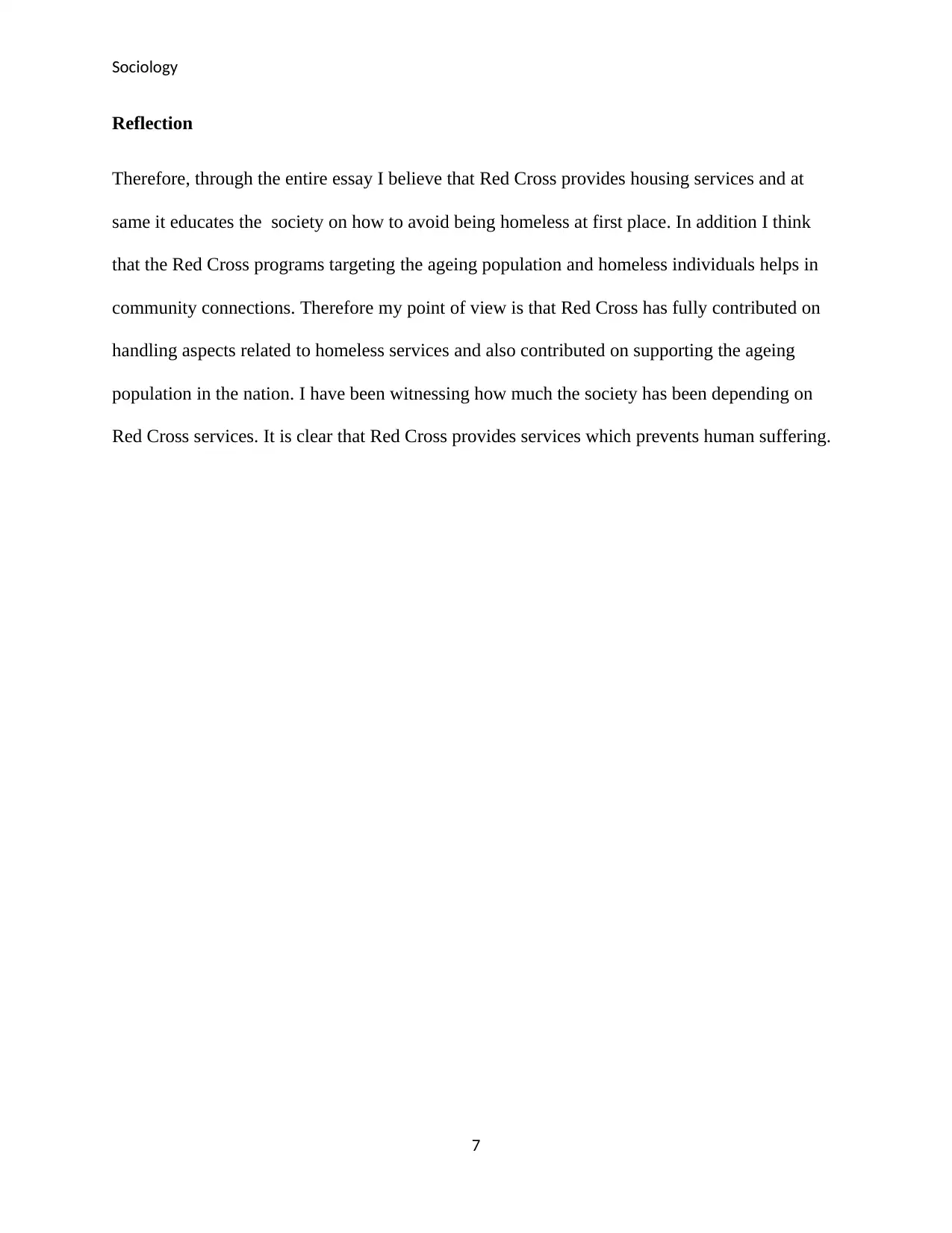
Sociology
Reflection
Therefore, through the entire essay I believe that Red Cross provides housing services and at
same it educates the society on how to avoid being homeless at first place. In addition I think
that the Red Cross programs targeting the ageing population and homeless individuals helps in
community connections. Therefore my point of view is that Red Cross has fully contributed on
handling aspects related to homeless services and also contributed on supporting the ageing
population in the nation. I have been witnessing how much the society has been depending on
Red Cross services. It is clear that Red Cross provides services which prevents human suffering.
7
Reflection
Therefore, through the entire essay I believe that Red Cross provides housing services and at
same it educates the society on how to avoid being homeless at first place. In addition I think
that the Red Cross programs targeting the ageing population and homeless individuals helps in
community connections. Therefore my point of view is that Red Cross has fully contributed on
handling aspects related to homeless services and also contributed on supporting the ageing
population in the nation. I have been witnessing how much the society has been depending on
Red Cross services. It is clear that Red Cross provides services which prevents human suffering.
7
Paraphrase This Document
Need a fresh take? Get an instant paraphrase of this document with our AI Paraphraser
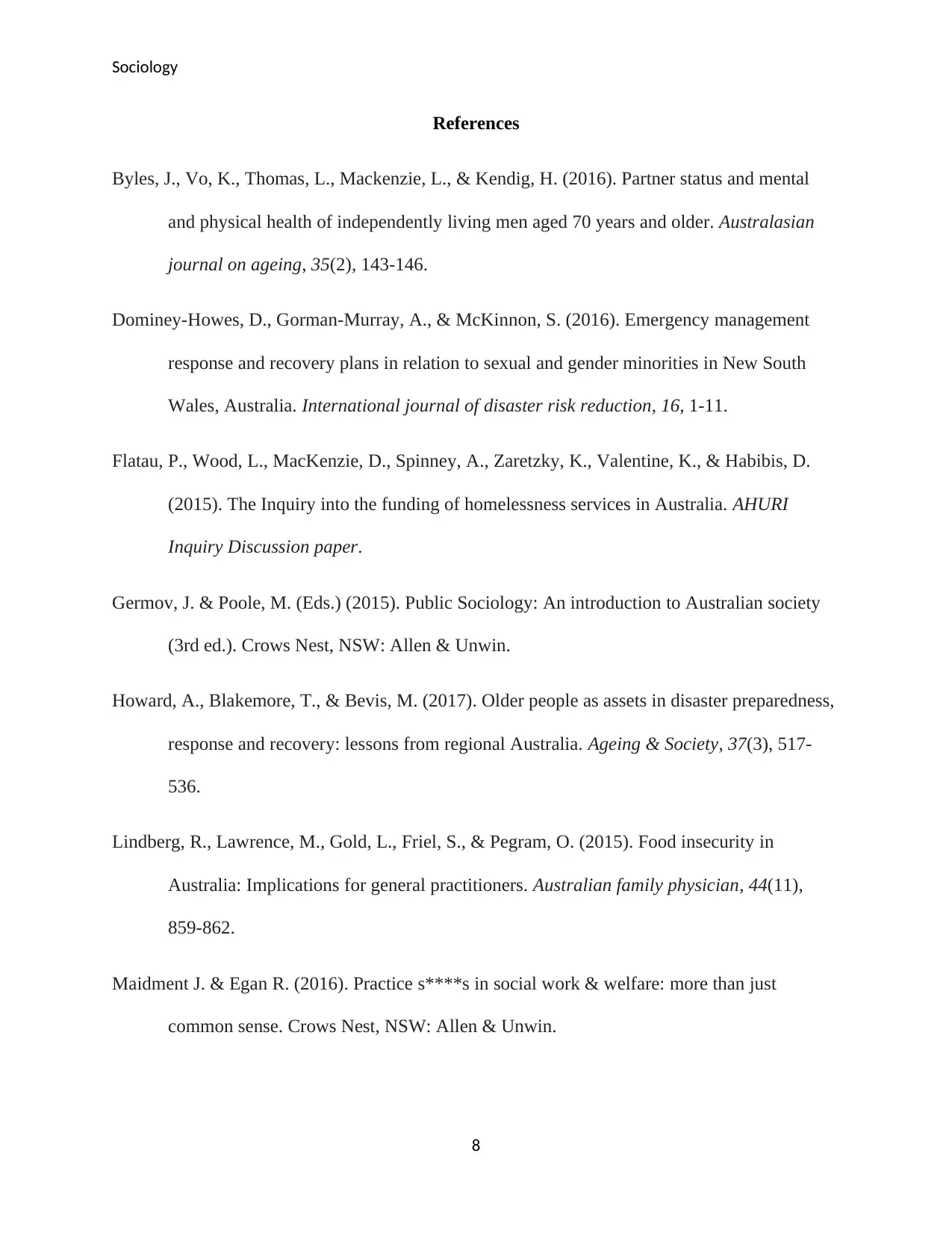
Sociology
References
Byles, J., Vo, K., Thomas, L., Mackenzie, L., & Kendig, H. (2016). Partner status and mental
and physical health of independently living men aged 70 years and older. Australasian
journal on ageing, 35(2), 143-146.
Dominey-Howes, D., Gorman-Murray, A., & McKinnon, S. (2016). Emergency management
response and recovery plans in relation to sexual and gender minorities in New South
Wales, Australia. International journal of disaster risk reduction, 16, 1-11.
Flatau, P., Wood, L., MacKenzie, D., Spinney, A., Zaretzky, K., Valentine, K., & Habibis, D.
(2015). The Inquiry into the funding of homelessness services in Australia. AHURI
Inquiry Discussion paper.
Germov, J. & Poole, M. (Eds.) (2015). Public Sociology: An introduction to Australian society
(3rd ed.). Crows Nest, NSW: Allen & Unwin.
Howard, A., Blakemore, T., & Bevis, M. (2017). Older people as assets in disaster preparedness,
response and recovery: lessons from regional Australia. Ageing & Society, 37(3), 517-
536.
Lindberg, R., Lawrence, M., Gold, L., Friel, S., & Pegram, O. (2015). Food insecurity in
Australia: Implications for general practitioners. Australian family physician, 44(11),
859-862.
Maidment J. & Egan R. (2016). Practice s****s in social work & welfare: more than just
common sense. Crows Nest, NSW: Allen & Unwin.
8
References
Byles, J., Vo, K., Thomas, L., Mackenzie, L., & Kendig, H. (2016). Partner status and mental
and physical health of independently living men aged 70 years and older. Australasian
journal on ageing, 35(2), 143-146.
Dominey-Howes, D., Gorman-Murray, A., & McKinnon, S. (2016). Emergency management
response and recovery plans in relation to sexual and gender minorities in New South
Wales, Australia. International journal of disaster risk reduction, 16, 1-11.
Flatau, P., Wood, L., MacKenzie, D., Spinney, A., Zaretzky, K., Valentine, K., & Habibis, D.
(2015). The Inquiry into the funding of homelessness services in Australia. AHURI
Inquiry Discussion paper.
Germov, J. & Poole, M. (Eds.) (2015). Public Sociology: An introduction to Australian society
(3rd ed.). Crows Nest, NSW: Allen & Unwin.
Howard, A., Blakemore, T., & Bevis, M. (2017). Older people as assets in disaster preparedness,
response and recovery: lessons from regional Australia. Ageing & Society, 37(3), 517-
536.
Lindberg, R., Lawrence, M., Gold, L., Friel, S., & Pegram, O. (2015). Food insecurity in
Australia: Implications for general practitioners. Australian family physician, 44(11),
859-862.
Maidment J. & Egan R. (2016). Practice s****s in social work & welfare: more than just
common sense. Crows Nest, NSW: Allen & Unwin.
8
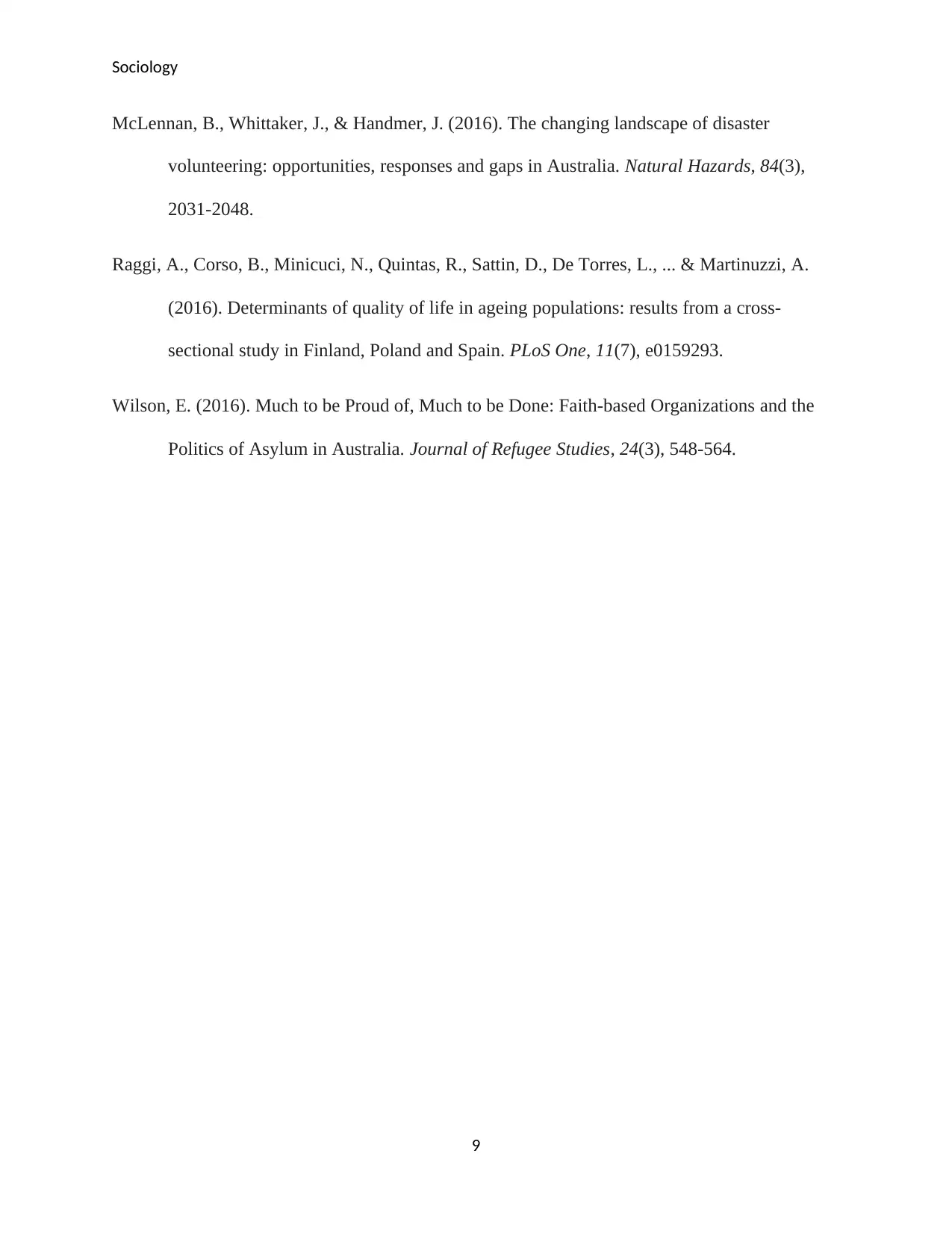
Sociology
McLennan, B., Whittaker, J., & Handmer, J. (2016). The changing landscape of disaster
volunteering: opportunities, responses and gaps in Australia. Natural Hazards, 84(3),
2031-2048.
Raggi, A., Corso, B., Minicuci, N., Quintas, R., Sattin, D., De Torres, L., ... & Martinuzzi, A.
(2016). Determinants of quality of life in ageing populations: results from a cross-
sectional study in Finland, Poland and Spain. PLoS One, 11(7), e0159293.
Wilson, E. (2016). Much to be Proud of, Much to be Done: Faith-based Organizations and the
Politics of Asylum in Australia. Journal of Refugee Studies, 24(3), 548-564.
9
McLennan, B., Whittaker, J., & Handmer, J. (2016). The changing landscape of disaster
volunteering: opportunities, responses and gaps in Australia. Natural Hazards, 84(3),
2031-2048.
Raggi, A., Corso, B., Minicuci, N., Quintas, R., Sattin, D., De Torres, L., ... & Martinuzzi, A.
(2016). Determinants of quality of life in ageing populations: results from a cross-
sectional study in Finland, Poland and Spain. PLoS One, 11(7), e0159293.
Wilson, E. (2016). Much to be Proud of, Much to be Done: Faith-based Organizations and the
Politics of Asylum in Australia. Journal of Refugee Studies, 24(3), 548-564.
9
⊘ This is a preview!⊘
Do you want full access?
Subscribe today to unlock all pages.

Trusted by 1+ million students worldwide
1 out of 9
Related Documents
Your All-in-One AI-Powered Toolkit for Academic Success.
+13062052269
info@desklib.com
Available 24*7 on WhatsApp / Email
![[object Object]](/_next/static/media/star-bottom.7253800d.svg)
Unlock your academic potential
Copyright © 2020–2025 A2Z Services. All Rights Reserved. Developed and managed by ZUCOL.





